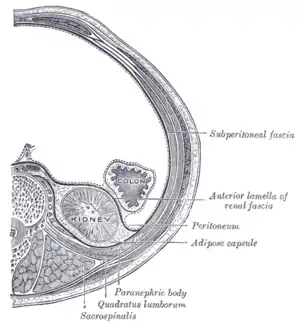Retroperitoneal bleeding
Retroperitoneal bleeding is an accumulation of blood in the retroperitoneal space. Signs and symptoms may include abdominal or upper leg pain, hematuria, and shock. It can be caused by major trauma or by non-traumatic mechanisms.
| Retroperitoneal bleeding | |
|---|---|
| Other names | Retroperitoneal hematoma, retroperitoneal hemorrhage |
 | |
| Transverse section, showing the relations of the capsule of the kidney. (Peritoneum is labeled at center right. Retroperitoneal space is behind peritoneum.) | |
| Specialty | General surgery |
Signs and symptoms
Signs and symptoms may include:
Causes
Retroperitoneal bleeds are most often caused by major trauma, such as from a traffic collisions or a fall.[3] Less common non-traumatic causes including:
- anticoagulation.[3][4][5]
- a ruptured aortic aneurysm.[5]
- a ruptured renal aneurysm.[6]
- acute pancreatitis.
- malignancy.[7]
Retroperitoneal bleeds may also be iatrogenic, caused accidentally during medical procedures. Such procedures include cannulating the femoral artery for cardiac catheterization or for interventional radiology,[3][5] and the administration of a psoas compartment nerve block.[5]
Diagnosis
Neurology
As well as initial symptoms, the accumulation of blood in the retroperitoneal space also compresses the femoral nerve. This may lead to weakness in extending the knee (with reduced patellar reflex) and weakness in flexing the hip.[8]
Radiology
A magnetic resonance imaging (MRI) scan may be used to identify the collection of blood, although this is often not performed if bleeding is a medical emergency.[3]
References
- Phillips, Courtney K; Lepor, Herbert (2006). "Spontaneous Retroperitoneal Hemorrhage Caused by Segmental Arterial Mediolysis". Reviews in Urology. 8 (1): 36–40. ISSN 1523-6161. PMC 1471764. PMID 16985559.
- Wang, Fengbiao; Wang, Fang (April 2013). "The diagnosis and treatment of traumatic retroperitoneal hematoma". Pakistan Journal of Medical Sciences. 29 (2): 573–576. doi:10.12669/pjms.292.3168. ISSN 1682-024X. PMC 3809226. PMID 24353579.
- Torigian, Drew A.; Siegelman, Evan S. (2005-01-01), Siegelman, Evan S. (ed.), "Chapter 6 - MRI of the Retroperitoneum and Peritoneum", Body MRI, Philadelphia: W.B. Saunders, pp. 207–268, doi:10.1016/b978-0-7216-3740-2.50011-x, ISBN 978-0-7216-3740-2
- John P. McGahan; Barry B. Goldberg (January 2008). Diagnostic ultrasound. Informa Health Care. pp. 772–. ISBN 978-1-4200-6978-5. Retrieved 20 April 2010.
- Weller, Robert S. (2007-01-01), Atlee, John L. (ed.), "Chapter 64 - Psoas Compartment Block: Potential Complications", Complications in Anesthesia (Second Edition), Philadelphia: W.B. Saunders, pp. 257–260, ISBN 978-1-4160-2215-2, retrieved 2021-01-05
- Anastasiou, Ioannis; Katafigiotis, Ioannis; Pournaras, Christos; Fragkiadis, Evangelos; Leotsakos, Ioannis; Mitropoulos, Dionysios; Constantinides, Constantinos A. (2013). "A Cough Deteriorating Gross Hematuria: A Clinical Sign of a Forthcoming Life-Threatening Rupture of an Intraparenchymal Aneurysm of Renal Artery (Wunderlich's Syndrome)". Case Reports in Vascular Medicine. 2013: 1–3. doi:10.1155/2013/452317. PMC 3705747. PMID 23864981.
- Marilyn J. Siegel (1 November 2007). Pediatric Body CT. Lippincott Williams & Wilkins. pp. 353–. ISBN 978-0-7817-7540-3. Retrieved 20 April 2010.
- Preston, David C.; Shapiro, Barbara E. (2013-01-01), Preston, David C.; Shapiro, Barbara E. (eds.), "32 - Lumbosacral Plexopathy", Electromyography and Neuromuscular Disorders (Third Edition), London: W.B. Saunders, pp. 501–517, doi:10.1016/b978-1-4557-2672-1.00032-5, ISBN 978-1-4557-2672-1, retrieved 2021-01-05